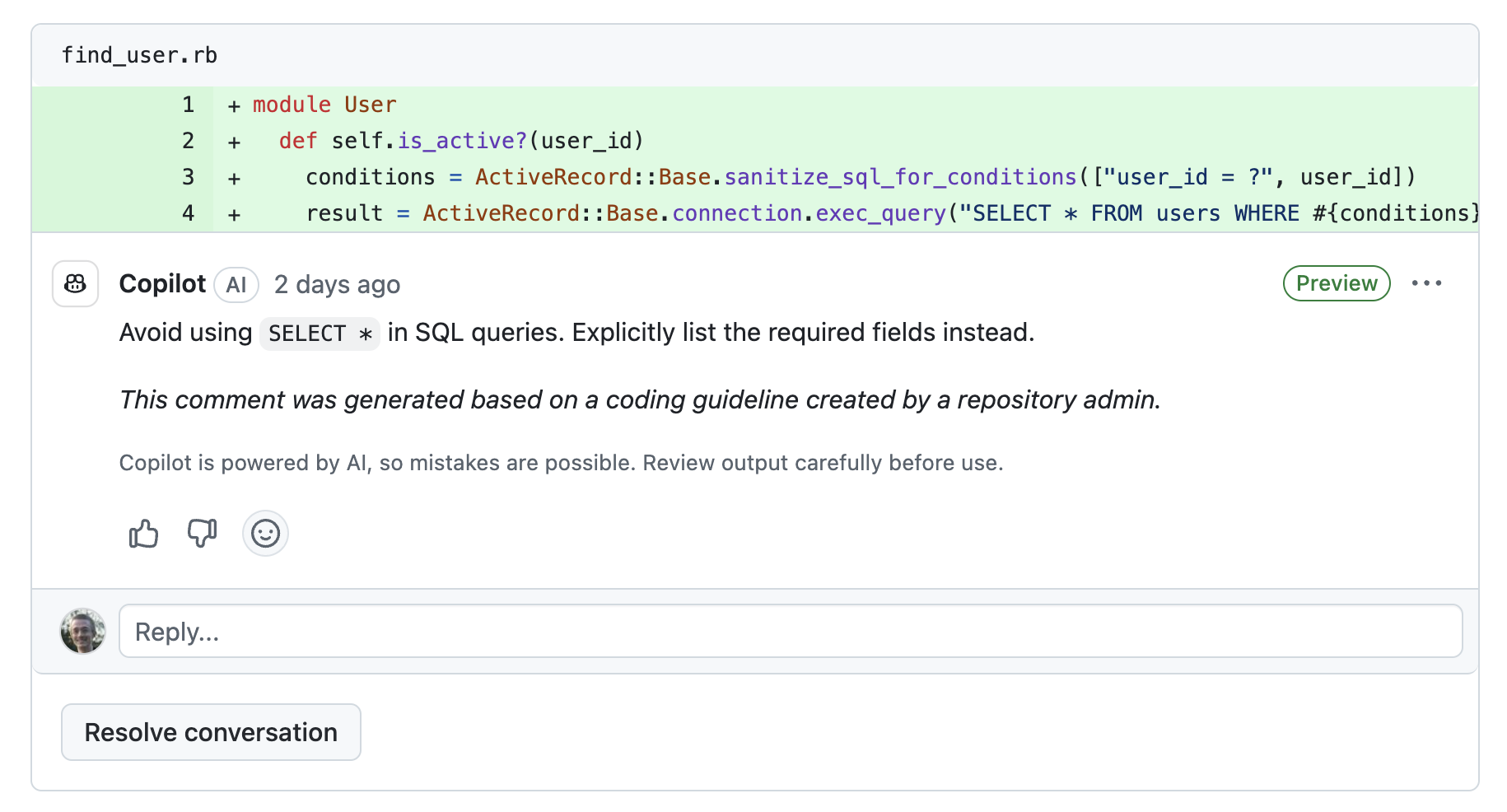Note
사용자 지정 코딩 지침은 Copilot 코드 검토의 공개 미리 보기에서 선택한 참가자로 제한되며, GitHub Copilot Enterprise에 대한 구독의 일부로만 사용할 수 있습니다.
코딩 지침 정보
자연어로 작성된 사용자 지정 코딩 지침으로 Copilot 코드 검토를 사용자 지정할 수 있습니다. Copilot 코드 검토에 대한 자세한 내용은 GitHub Copilot 코드 검토 사용을(를) 참조하세요.
코딩 지침을 통해 Copilot은 조직의 특정 코딩 스타일 및 모범 사례에 따라 피드백을 제공할 수 있습니다.
Copilot 코드 검토는 대규모 언어 모델을 통해 구동되므로 Linter 또는 정적 분석 도구에서 다루지 않는 코딩 지침을 적용하는 데 도움이 될 수 있습니다.
코딩 지침은 리포지토리 수준에서 구성됩니다. 리포지토리당 최대 6개의 코딩 지침을 만들고 사용하도록 설정할 수 있습니다.
Note
- 코딩 지침은 Copilot 코드 검토에서 지원하는 언어로만 작동합니다. 지원되는 언어 목록은 GitHub Copilot 코드 검토 사용을(를) 참조하세요.
- 코딩 지침은 Copilot이 수행하는 코드 검토에만 적용됩니다. 이 지침은 Copilot 코드 완성 제안이나 Copilot 채팅 응답에 제안된 코드에는 영향을 미치지 않습니다.
코딩 지침에 대한 해야 할 일과 하지 말아야 할 일
- ** 간단하고 명확하며 간결한 언어를 사용하여 코딩 지침을 설명합니다**.
- ** Copilot가 무엇을 찾아야 하는지, 즉 코드에서 보고 싶거나 보고 싶지 않은 것에 대해 가능한 한 구체적으로 설명합니다**.
- 아래의 코딩 지침 예제를 참고하여 영감을 얻으세요.
- 코딩 지침을 사용하여 Linter 또는 정적 분석 도구에서 다룰 수 있는 스타일 지침을 적용하지 마세요.
- 모호하거나 다른 방식으로 해석될 수 있는 단어를 사용하지 마세요.
- 여러 아이디어를 단일 코딩 지침에 맞추지 마세요.
코딩 지침 만들기
-
GitHub에서 리포지토리의 기본 페이지로 이동합니다.
-
리포지토리 이름 아래에서 설정을 클릭합니다. "설정" 탭이 표시되지 않으면 드롭다운 메뉴를 선택한 다음 설정을 클릭합니다.

-
사이드바의 "코드 및 자동화" 섹션에서 Copilot 을 클릭한 다음 코드 검토를 클릭합니다.
-
지침 만들기를 클릭합니다.
-
"이름"에서 코딩 지침에 이름을 지정합니다.
-
"설명"에서 최대 600자까지 코딩 지침에 대한 설명을 제공합니다. Copilot에서 코딩 스타일을 이해하고 설명을 남길 시기를 결정하는 데 사용됩니다.
설명을 작성하는 방법은 Copilot에서 생성할 댓글 품질에 큰 영향을 줍니다. 효과적인 코딩 지침 작성에 대한 도움말은 상단의 코딩 지침에 대한 해야 할 일과 하지 말아야 할 일과 하단의 코딩 지침 예제를 참조하세요.
-
필요에 따라 파일 경로 추가를 클릭하고 경로 패턴을 추가하여 코딩 지침을 특정 파일 형식 또는 경로로 제한합니다.
fnmatch구문을 사용하여 대상 경로를 정의할 수 있으며*을(를) 모든 문자열과 일치하는 와일드카드로 지정할 수 있습니다.GitHub에서
File::FNM_PATHNAME플래그를File.fnmatch구문에 사용하므로*와일드카드는 디렉터리 구분 기호(/)와 일치하지 않습니다. 예를 들어qa/*은qa/로 시작하고 단일 슬래시를 포함하는 모든 분기와 일치하지만qa/foo/bar과 일치하지 않습니다.. 다음과 같이qa과 일치하는qa/**/*는 슬래시를 원하는 대로, 예를 들어qa/foo/bar/foobar/hello-world포함할 수 있습니다.qa문자열을qa**/**/*와 확장하여 규칙을 더 포괄적으로 만들 수도 있습니다.구문 옵션에 대한 자세한 내용은 fnmatch 문서를 참조하세요.
-
코딩 지침을 테스트하여 예상대로 작동하는지 확인합니다.
- 샘플 추가를 클릭합니다.
- 사용자 고유의 샘플을 추가하거나 코드 샘플 생성을 눌러 제목 및 설명에 따라 코드 샘플을 자동으로 생성합니다.
- 저장을 클릭하여 코드 샘플을 저장합니다.
- 실행을 눌러 샘플에 대한 코딩 지침을 테스트합니다.
-
코딩 지침을 저장하고 지침 저장을 클릭하여 설정합니다.
코딩 지침을 사용하여 검토 실행
Copilot에서 검토를 요청하면 리포지토리의 사용 가능한 코딩 지침을 자동으로 사용하여 코드를 검토합니다. 자세한 내용은 GitHub Copilot 코드 검토 사용을(를) 참조하세요.
코딩 지침에 따라 생성된 메모에는 해당 원본을 강조 표시하는 메시지가 포함됩니다.

코딩 지침 예제
예제 1: 매직 넘버 사용 방지
제목: Avoid using magic numbers
설명: Don't use magic numbers in code. Numbers should be defined as constants or variables with meaningful names.
경로 패턴:**/*.py
예제 2: SQL 쿼리에서 SELECT *을(를) 사용하지 않음
제목: Don't use `SELECT *` in SQL queries
설명: Don't use `SELECT *` in SQL queries. Always specify the columns you want to select. `COUNT(*)` is allowed.
경로 패턴: 없음(SQL 쿼리가 코드에 포함될 수 있으므로 모든 파일 형식에 적용됨).
예제 3: HTTP 요청에 fetch 사용
제목: Use `fetch` for HTTP requests
설명: Use `fetch` for HTTP requests, not `axios` or `superagent` or other libraries.
경로 패턴:**/*.ts, **/*.js, **/*.jsx **/*.tsx
예제 4: 항상 현재 환경을 사용하여 메트릭 태그 지정
제목: Always tag metrics with the current environment
설명: Always include a `env` tag with the current environment when emitting metrics, for example, `env:prod` or `env:dev`.
경로 패턴:*/*.go, */*.java